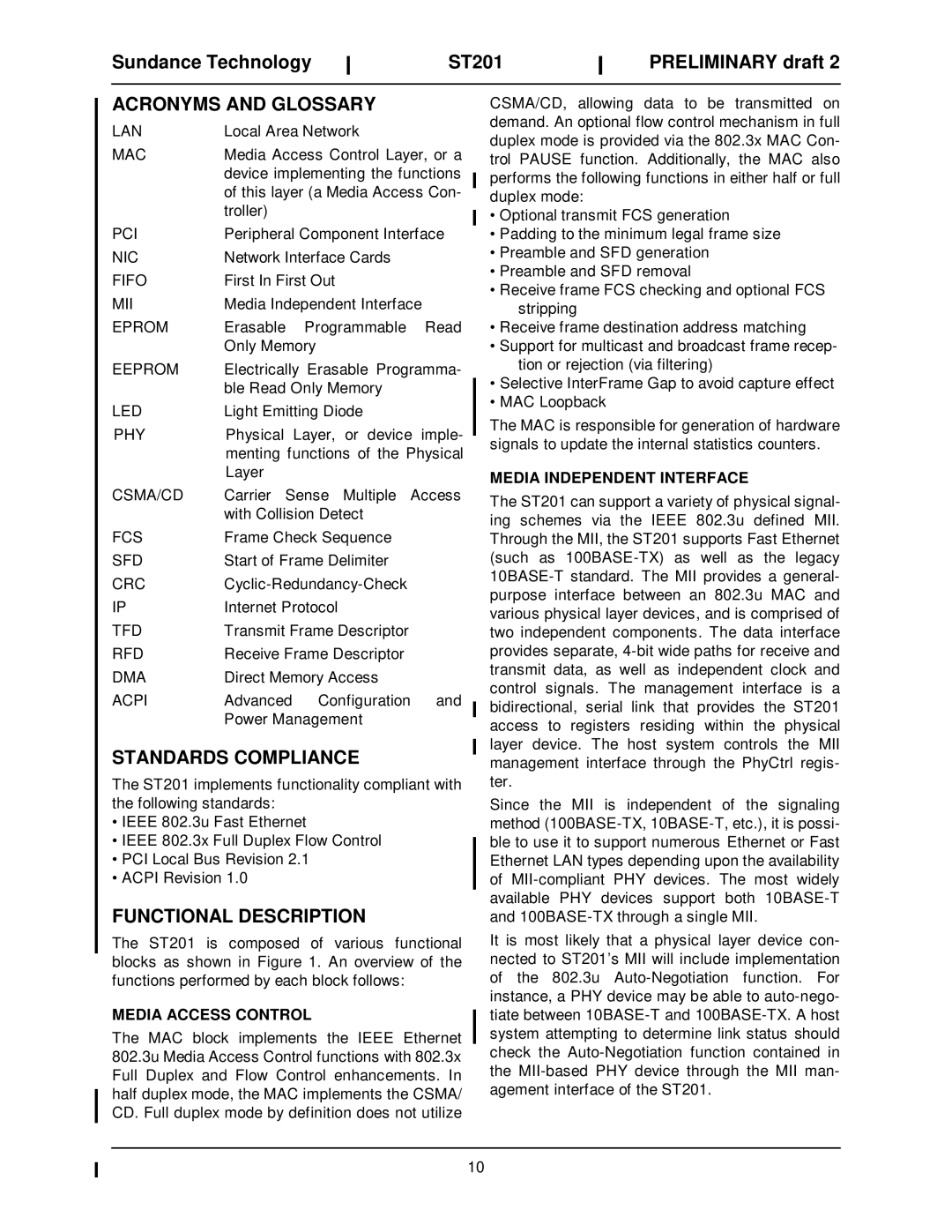
Sundance Technology
ST201
PRELIMINARY draft 2
ACRONYMS AND GLOSSARY
LAN | Local Area Network |
| |
MAC | Media Access Control Layer, or a | ||
| device implementing the functions | ||
| of this layer (a Media Access Con- | ||
| troller) |
|
|
PCI | Peripheral Component Interface | ||
NIC | Network Interface Cards |
| |
FIFO | First In First Out |
| |
MII | Media Independent Interface |
| |
EPROM | Erasable | Programmable | Read |
| Only Memory |
| |
EEPROM | Electrically Erasable Programma- | ||
| ble Read Only Memory |
| |
LED | Light Emitting Diode |
| |
PHY | Physical Layer, or device imple- | ||
| menting functions of the Physical | ||
| Layer |
|
|
CSMA/CD | Carrier Sense Multiple Access | ||
| with Collision Detect |
| |
FCS | Frame Check Sequence |
| |
SFD | Start of Frame Delimiter |
| |
CRC |
| ||
IP | Internet Protocol |
| |
TFD | Transmit Frame Descriptor |
| |
RFD | Receive Frame Descriptor |
| |
DMA | Direct Memory Access |
| |
ACPI | Advanced | Configuration | and |
| Power Management |
| |
STANDARDS COMPLIANCE
The ST201 implements functionality compliant with the following standards:
•IEEE 802.3u Fast Ethernet
•IEEE 802.3x Full Duplex Flow Control •PCI Local Bus Revision 2.1
•ACPI Revision 1.0
FUNCTIONAL DESCRIPTION
The ST201 is composed of various functional blocks as shown in Figure 1. An overview of the functions performed by each block follows:
MEDIA ACCESS CONTROL
The MAC block implements the IEEE Ethernet 802.3u Media Access Control functions with 802.3x Full Duplex and Flow Control enhancements. In half duplex mode, the MAC implements the CSMA/ CD. Full duplex mode by definition does not utilize
CSMA/CD, allowing data to be transmitted on demand. An optional flow control mechanism in full duplex mode is provided via the 802.3x MAC Con- trol PAUSE function. Additionally, the MAC also performs the following functions in either half or full duplex mode:
•Optional transmit FCS generation
•Padding to the minimum legal frame size
•Preamble and SFD generation
•Preamble and SFD removal
•Receive frame FCS checking and optional FCS stripping
•Receive frame destination address matching
•Support for multicast and broadcast frame recep- tion or rejection (via filtering)
•Selective InterFrame Gap to avoid capture effect
•MAC Loopback
The MAC is responsible for generation of hardware signals to update the internal statistics counters.
MEDIA INDEPENDENT INTERFACE
The ST201 can support a variety of physical signal- ing schemes via the IEEE 802.3u defined MII. Through the MII, the ST201 supports Fast Ethernet (such as
Since the MII is independent of the signaling method
It is most likely that a physical layer device con- nected to ST201’s MII will include implementation of the 802.3u
10
